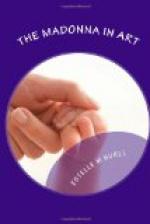It will have been noticed that the throne is an especially appropriate setting for the Madonna as Witness. It is one of the functions of royalty that the queen should show the prince to his people. We therefore turn naturally to this class of pictures for examples. To those of Bellini just cited we may add, from the others mentioned in the second chapter, the Madonnas by Cima, by Palma, and by Montagna in Venetian Art; and by Luini and by Botticelli in the Lombard and Florentine schools respectively. Luini’s picture is one which readily touches the heart. The Virgin unites the sweetness of fresh, young motherhood with womanly dignity of character. Her smile has nothing of mystery in it; it is simply sweet and winning. The Christ-child is a lovely boy, steadying himself against his mother’s breast, and yet with an air of self-reliance. The two understand each other well.
[Illustration: LUINI.—MADONNA WITH ST. BARBARA AND ST. ANTHONY.]
One could hardly imagine two more dissimilar spirits than Luini and Botticelli. To Luini’s Virgin, the consciousness of her son’s greatness is a proud honor, accepted seriously, but gladly. To Botticelli, on the other hand, it brings a profound melancholy. This is so marked that at first sight almost every one is repelled by Botticelli, and yields only after long familiarity to the mysterious fascination of the sad-eyed Madonna, who holds her babe almost listlessly, as her head droops with the weight of her sorrow. Her expression is the same whatever her attitude, when she presses her babe to her bosom as the Mater Amabilis (in the Borghese Gallery at Rome, in the Dresden Gallery, and Louvre), or when, as witness to her son’s destiny, she holds him forth to be seen of men. It is in this last capacity that her mood is most intelligible. She seems oppressed rather than humbled by her honors; reluctant, rather than glad to assume them; yet, with proud dignity, determined to do her part, though her heart break in the doing. Her nature is too deep to accept the joy without counting the cost, and her vision looks beyond Bethlehem to Calvary. This is well illustrated in the picture of the Berlin Gallery.[6] The queen mother rises with the prince to receive the homage of humanity. The boy, old beyond his years, gravely raises his right hand to bless his people, the other still clinging, with infantile grace, to the dress of his mother. Lovely, rose-crowned angels hold court on either side, bearing lighted tapers in jars of roses.
[Footnote 6: The Berlin Gallery contains two Enthroned Madonnas attributed to Botticelli. The description here, and on page 40 makes it clear that the reference is to the picture numbered 102. This does not appear in Berenson’s list of Botticelli’s works, but is treated as authentic by Crowe and Cavalcaselle.]
The Madonna of the Pomegranate is another work by Botticelli which belongs in this class of pictures. It is a tondo in the Uffizi, showing the figures in half length. The Virgin, encircled by angels, holds the child half reclining on her lap. Her face is inexpressibly sad, and the child shares her mood, as he raises his little hand to bless the spectator. Two angels bear the Virgin’s flowers, roses and lilies; two others hold books. They bend towards the queen as the petals of a rose bend towards the centre, with the serious grace peculiar to Botticelli.




